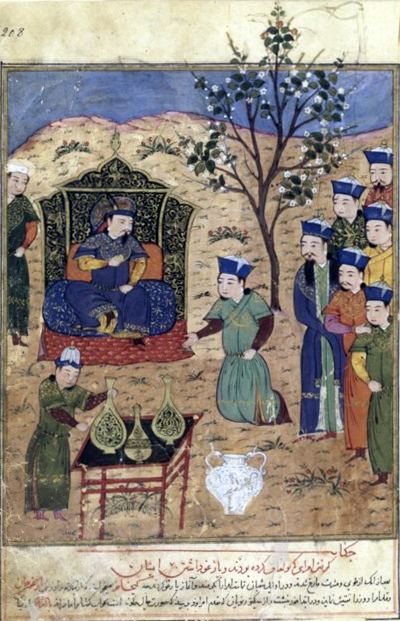Name Gaykhatu Gaykhatu Died March 24, 1295 | Siblings Arghun Parents Abaqa Khan | |
 | ||
Grandparents Hulagu Khan, Doquz Khatun, Yesuncin Khatun People also search for | ||
Great-grandparents Tolui, Sorghaghtani Beki | ||
Gaykhatu (Mongolian: Gaikhalt; Mongolian Cyrillic: Гайхалт, died 1295) was the fifth Ilkhanate ruler in Iran. He reigned from 1291 to 1295. During his reign, Gaykhatu was a noted dissolute who was addicted to wine, women, and sodomy, according to Mirkhond. His Buddhist baghshi gave him the Tibetan name Rinchindorj.
Contents
His name means "amazing/surprising" in the Mongolian language as in "gaikhakh" (to get surprised).
Reign
He had originally been governor of Seljuk Anatolia, and was nominated for the throne by an influential Mongol commander, Ta'achar, who had murdered Gaykhatu's brother, the then paralyzed Ilkhan Arghun. Ta'achar intended to promote Baydu, but when Baydu didn't appear at the quriltai, Gaykhatu was enthroned instead. During his reign, the princess Kökötchin had arrived from the court of his Khagan Kublai, escorted by none other than Marco Polo. The new Ilkhan decreed that the princess be married to his nephew Ghazan, who had fully supported his right to rule. Gaykhatu's wife, Padshah, was the daughter of Kütlugh Turkan (Turkan Khatun) of Kirman. Padshah had taken the title of Safwat al-dunya wa al-Din (literally, Purity of the earthly world and of the faith) after Djalal da-Din Abu'l-Muzzafar was deposed as head of the Mongol tribe that reigned in southeastern Iran. Padshah was known for the murder of her stepbrother, Suyurghatamish. One of his clansmen, Khurdudjin, managed to avenge him by putting her to death, with the tacit approval of the later Ilkhan, Baydu.
In 1292, Gaykhatu had sent a message to the Egyptian Mamluk Sultan Al-Ashraf Khalil, threatening to conquer the whole of the Levant if he was not allowed to live in Aleppo. Al-Ashraf replied: "The khan has the same ideas as me. I too hope to bring back Baghdad to the fold of Islam as previously. We will see which of us two will be quicker".
Royal extravagance
Gaykhatu is known to have spent government money in an extravagant way. Among his beneficiaries were the Nestorian Christians, who praise him abundantly for his gifts to the Church, as apparent in the history of Mar Yahballaha III.
Introduction of paper money
In 1294, Gaykhatu wanted to replenish his treasury emptied by royal extravagance and a great cattle plague. In response, his vizier Ahmed al-Khalidi proposed the introduction of a recent Chinese invention called Chao (paper money). Gaykhatu agreed and called for Kublai Khan's ambassador Bolad in Tabriz. After the ambassador showed how the system worked, Gaykhatu printed banknotes which imitated the Chinese ones so closely that they even had Chinese words printed on them. The Muslim confession of faith was printed on the banknotes to placate local sentiment.
The plan was to get his subjects to use only paper money, and allow Gaykhatu to control the treasury. The experiment was a complete failure, as the people and merchants refused to accept the banknotes. Soon, bazaar riots broke out, economic activities came to a standstill, and the Persian historian Rashid ud-din speaks even of "'the ruin of Basra' which ensued upon the emission of the new money". Gaykhatu had no choice but to withdraw the use of paper money.
He was assassinated shortly after that, strangled by a bowstring so as to avoid bloodshed. His cousin Baydu, another puppet placed by Ta'achar, succeeded Gaykhatu but only lasted a few months before himself being assassinated. An alternative story of Gaykhatu's death claims Baydu made war on him because of his introduction of paper money and subsequently killed him in battle.
